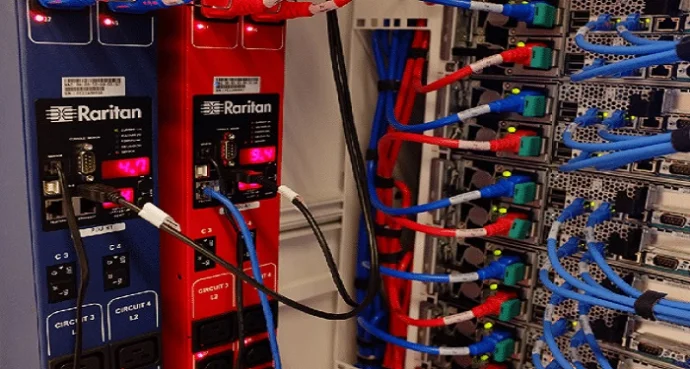How to Choose PDUs For Server Racks
Choosing the right power distribution units (PDUs) is a critical element when designing your power protection plan and server rack load management. But what is a PDU and which is the right type for your installation.
A basic Power Distribution Unit or PDU is a strip of power sockets in a self-contained unit that may be horizontally or vertically mounted and which provides power from a source to the loads connected to the power outlets.
To fully understand the important of choosing the right PDUs for your server room or datacentre environment, it is important to understand the critical power path within the entire building. Power enters a building through a Point of Common Coupling (PPC) from the outside local electricity grid to the building’s LV switchboard. The switchgear will typically be a three-phase configuration from which power will be distributed through sub-distribution boards to supply building loads including critical, essential and non-essential systems.
Critical loads are those required for the organisation within the building to operate and deliver its services and products. Within a server room or datacentre, the systems are IT and server related. The electrical supply to the server room or datacentre may come via an uninterruptible power supply or UPS systems may be installed within the room or server racks themselves. The PDUs therefore provide a common connection point to the output supply from the UPS systems. The PDUs may be plugged into the output socket(s) of the UPS or hardwired to the UPS or an external maintenance bypass switch.
Types of Power Distribution Unit
There are three generic types of power distribution unit which can be single or three phase and range in price and features from basic to metered to intelligent:
- Basic PDUs: as the name suggest this is an entry-level basic PDU and is little more than a socket strip. The unit connects to its supply and provider power via output sockets or outlets. A built-in breaker provides overload protection. The power supplied to the sockets may have surge and spike protection.
- Metered PDUs: this type of PDU includes a total power meter that monitors power consumption and can provide a range of data including energy usage (kWh), total load profile (kVA/kW/pF) and the voltage and frequency of the supply.
- Intelligent or Smart PDUs: here smart monitoring and control features are built-into a metered PDU to open even more power and energy management information. Data will be available down to individual sockets/outlets (with up to ±1% accuracy) as will control allowing a datacentre or IT manger to power down or reboot a single socket using an TCP/IP SNMP connection. The PDU itself will incorporate an LDC that may be rotatable to suite a horizontal or vertical installation allowing local readings and alarm notifications. Where there is no budget constraint an intelligent PDU is always the preferred choice due to the greater monitoring and control functions they provide.
Server Room and Datacentre Rack PDUs
Within a datacentre environment intelligent PDUs are becoming the norm due to the amount of information they can provide. In a Colocation (Colo) datacentre the information provided allows for accurate client billing and load utilisation. In an Enterprise datacentre, the information gained from an intelligent PDU allows the datacentre manager to optimise space and rack usage, as well as tracking overall energy consumption.
The more advanced intelligent PDUs can provide further enhancements including mass configuration and firmware updating from a central software management or Data Centre Infrastructure Management (DCIM) architecture.
Working within any server cabinet can be fraught with danger. Access can be hampered by cables, bulky connection and oversized power distribution units. This can make it difficult to replace server fans and power supplies or add additional servers and IT equipment to the racks themselves.
The latest intelligent PDUs for datacentre and server racks overcome this with a low form factor allowing easier access within confined spaces. The use of locking sockets and power cords prevents accidental disruption. The use of colour coded cables, plugs and outlets also provides easy server/load group identification.
Most datacentre environments try to maintain a working ambient temperature of 20-25˚C. This provides a pleasant working environment and is ideal for UPS batteries installed within the data hall or server room area. PDUs can see a heat build-up and especially in the larger sized three-phase models. To prevent issues PDUs should be made from an aluminium-type material that can easily dissipate any heat build-up. This type of construction is also lightweight and rugged making installation and even relocation easier.
In addition to monitoring power, PDUs can provide information on the local environment using plug-in options including ambient temperature monitors, humidity and water detection and even access control.
Choosing the right power distribution units for your server room or datacentre server racks can have a large impact on overall load reliability, monitoring and control. The more intelligent the PDU itself, the greater it can contribute towards environmental, energy efficiency and management of the critical loads themselves.
At Server Room Environments supply a wide range of power distribution units including single and three phase PDUs as well as a range of power cords (including locking) and additional accessories for environment monitoring and remote management.

























